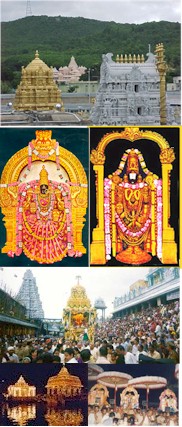Welcome to Adiyen Sri Ramanuja Dasan !
" Srimathe Ramanujaya Namaha !"
Levity apart, why should we apply oordhvapundram at all, whether one or a dozen? What do we gain therefrom, except the curious glances of some passers-by and derisive comment from the more offensive? What practical benefit do we derive from the practice, which would encourage its continued performance? What does it stand for and what is the scriptural authority behind it? Is its continued observance required in this age of satellites and missiles or is it a a mere vestige of anachronistic observances?
We are told by none other than the Lord Himself that He resides along with Taayar on the foreheads of those wearing Tiruman. The two parallel white lines of Tiruman indicate the Lord's holy feet, while the red or yellow vertical line in between signifies Piratti's(consorts) presence. Here is the BrahmANda PurANa sloka attesting to this, One who wears oordhvapundram provides a temple for the Lord on his own forehead, says this couplet, pointing out the Lord resides with pleasure in those who wear His tiruvadi with devotion.
That this practice is hoary and age-old, The word "oordhvam" means "upwards": according to Shastras, Paradise and other worlds of pleasure, ephemeral and eternal, lie above us, while worlds of pain and punishment inhabited by sinners lie below us. Hence the wearing of Tiruman in an upward direction is symbolic of our vertical movement on the spiritual plane.
In our Sampradaya, this adornment on the forehead in known as "tiruman kAppu".
The use of the word "kAppu", referring to protection, is significant, for, it denotes the constant protection afforded to the wearer. Tiruman thus acts as an effective and inexpensive shield against all untoward things and as a guard against all evil forces. It is said that Yama kinkarAs have standing orders not to harass Vishnu bhaktas and to confine their terrifying tantrums to others, for even Yama's writ doesn't run over devotees of the Lord-("prabhuraham anya nruNAm na vaishnavAnAm"). It is the Tiruman Kappu that affords instant identification of the wearer as a staunch votary of Emperuman, thus saving him from the clutches of the hounds of hell.
Like an Eton tie, a Harvard sweat shirt or a Cambridge Rowing Cap, the Tiruman Kappu too is a badge of membership, establishing the credentials of the wearer as an ardent devotee of the Lord and providing instant access to the Old Boys' Club of those who belong to the Lord.
It was, and still is the practice, to brand our belongings like pots and pans, to facilitate their identification, should they get mixed up with others'. Some have their initials or whole names etched on the pots while some put in distinctive marks. Similar to this practice, the wearing of Tiruman is to identify ourselves as the slaves of the Supreme Lord and Master, existing solely for His use and pleasure. What better way of inculcating the spirit of service to Bhagavan, than to constantly remind ourselves of His SwAmitvam (Lordship) and our own status as His belongings, by wearing His holy feet symbolically on our foreheads? That this SEshatvam of ours is not only towards the Lord but also towards His Consort, is signified by the Srichoornam.
Jai Srimannaryana !
Thanks for your valuable time. Visit our web site again for more information and latest updates.

